
Dental Procedures
Fairfield Dental
At the Fairfield Village Dental Centre, we've been providing quality dental care and professional services to families, kids and seniors for four generations; so whether you're deciding on a new dentist, or just dropping by our office to get more information, you can feel confident that you've made a good choice in Dr. Justin Yin.
Services Overview
Because dentists believe the best teeth are your own teeth, modern dental offices perform many different dental procedures to make sure you keep your teeth.
Your dentist may recommend a treatment or procedure to restore or replace a tooth that has been lost or damaged or to improve the appearance, health and function of your teeth. Some of these procedures are straightforward, while others are more involved.
The information in this section has been provided to help you understand the different treatments and procedures available to keep your smile healthy.
Cosmetic & Restorative
Dental Implants — Dental implants are used to replace missing roots and support replacement teeth.
Dental Implants are often the ideal solution for replacing a lost tooth. The 'implant' is the artificial tooth root made of titanium. A crown is then made by a lab to custom match your teeth. The advantages of implants over bridges and dentures are: no need to cut other teeth, easier to keep it clean and disease-free, preserves more of your natural bone supporting your teeth, better long term prognosis than a bridge.
Bridges and Dentures — Bridges and dentures are 2 ways to restore a badly damaged tooth or replace a lost tooth.
Crowns — If your tooth is damaged but not lost, a crown (also called a cap) can be used to cover the damaged part of your tooth. A crown protects your tooth from further damage.
Fillings — There are several different types of fillings that can be used to fill a cavity, but the final decision on which type of filling is placed in your mouth is yours alone.
Root Canal Treatment — Root canal treatment is the process of removing the infected, injured or dead pulp from a tooth.
Teeth whitening — Although teeth are not naturally meant to be completely white, many Canadians want a brighter smile. Responding to this desire, a wide range of "whitening" options has become available to consumers.
Bonding and Veneers — Bonding and veneers make your teeth look better by changing their colour, shape or spacing.
Orthodontics — Orthodontic treatment uses braces or other appliances to put gentle pressure on your teeth and eventually move them into the right position. They can either be fixed or removable.
Care After Minor Oral Surgery — After minor oral surgery, you may have pain, bleeding and swelling. This section offers some advice on dealing with these problems.
This information is intended for informational use only and does not replace the professional care of your dentist. Only your dentist has the skills, training and expertise to identify and address all your oral health care needs. If you have a question or concern about your oral health, please talk to your dentist.
General Dentistry
The Dental Exam — The exam consists, in part, of the dentist looking inside your mouth. In the past, you may not have ever realized an exam was taking place. Perhaps you thought the dentist was checking the work the hygienist had just completed.
Professional Cleanings — Cleanings will be done either with an ultrasonic scaler or hand scaler to remove plaque and tartar. Mechanical polishing is done to remove stains if needed. The frequency of cleanings is based on individual need, as some people benefit from having cleanings more often.
Fluoride Treatments — The need for a fluoride treatment is determined on an individual basis in consideration of the risk of cavities. This can be especially important for children and for older adults with exposed root surfaces.
Tooth Desensitization — We offer a selection of treatments and products to help with teeth that have become sensitive to heat, cold or sweets.
Sealants — Sealants are thin plastic coatings that are painted onto the biting surfaces of the back teeth to prevent decay in deep grooves prone to decay.
Custom Sports Mouthguards — Tooth protection during contact sports.
Grinding Guards — Preventative care to avoid damaged teeth due to nighttime grinding.
Preventive Care — At Fairfield Village Dental Centre we place a high value on preventing dental disease before it starts. This helps to avoid difficult and costly dental problems as well as to preserve the lifespan of fillings and crowns you may already have.
Treatment Concerns — Oral health care is a personalized service that requires a good relationship between you and your dentist. If you have a concern about the dental treatment you receive, your dentist would want to know about it.
 Copyright © Canadian Dental Association, Inc.
Copyright © Canadian Dental Association, Inc.
Content reproduced with permission.

Cosmetic & Restorative
Fairfield Dental
Cosmetic dental treatment can improve your smile and give you more confidence.
Dental Implants - Replacing Missing Teeth
If one or more of your teeth are missing, there are a number of ways to replace them. An alternative to bridges, partials or complete dentures may be dental implants. Implants are used to replace missing roots and support artificial replacement teeth. They are comfortable and look like natural teeth.
What are dental implants?
A dental implant is an artificial root made of titanium metal. It is inserted into the jawbone to replace the root of the natural tooth. An artificial replacement tooth is attached to the implant. The implant acts as an anchor to hold the replacement tooth in place.
Who can get dental implants?
If you are in good general health, have healthy gums and have enough bone in the jaw to hold an implant, dental implants might be right for you. If your jawbone has shrunk or if it has not developed normally, you may be able to have a bone graft to build up the bone. A bone graft is a way of adding new bone to your jawbone. Your dentist will tell you if bone grafting can be done.
How dental implants are done
- Your dentist will carefully examine your mouth and take x-rays of your head, jaw and teeth to find out if dental implants are right for you.
- During the first stage of surgery, your dentist will put a dental implant into your jawbone beneath the gum tissue. The gum tissue is then stitched back into place. As the tissue heals, the implant will bond with the bone and attach to the gum. It can take several months to heal.
- During the second stage of surgery and once the tissue is healed, your dentist will attach an abutment to the implant. An abutment is a post that connects the replacement tooth to the implant. In some cases, the first and second stage of implant surgery may be done in one single stage.
- An artificial replacement tooth is made and your dentist attaches it to the abutment. It may take several appointments to properly fit the replacement tooth to the abutment.
- When replacing several teeth or all of your teeth, a fixed bridge is anchored to your dental implants. A bridge is a dental restoration that replaces one or more missing teeth by spanning an area that has no teeth. The bridge is held firmly in place by dental implants on each side of the missing tooth or teeth.

A dental implant is inserted into the jawbone.
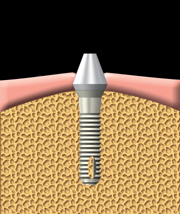
An abutment is attached to the implant.
The abutment connects the artificial tooth to the implant.
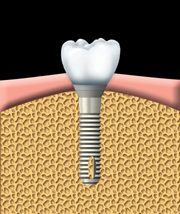
An artificial tooth is attached to the abutment.
Properly fitting the artificial
tooth may take several appointments.

A fixed bridge is anchored to dental implants to replace one or more teeth.
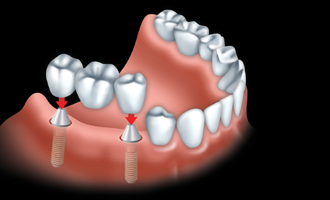
A fixed bridge is anchored to dental implants to replace all teeth.
Caring for my dental implant(s)
Because dental implants are placed in the jawbone, artificial replacement teeth attached to implants look and act much like natural teeth. Like natural teeth, implants need to be kept clean using a toothbrush and floss. Your dentist will show you the proper cleaning procedure for implants. Regular dental checkups are important so your dentist can make sure that your bite is right and that your implants are not loose.
What else should I know?
- Several visits to your dentist may be needed until the process is done.
- Checkups will be scheduled during the following year so your dentist can be sure your implants are working properly.
- You will need to take very good care of your implants.
- Implants can cost more than other kinds of replacement teeth and might not be covered by your dental plan. But in most cases this is a one-time cost, unlike other kinds of tooth replacement procedures.
- Although rare, possible complications due to dental implants include bleeding, infection, numbness or injury to nearby muscles or the sinus cavity. In some cases, the implant may not be successful because it didn’t bond to the bone.
 Copyright © Canadian Dental Association, Inc.
Copyright © Canadian Dental Association, Inc.
Content reproduced with permission.
Bridges & Dentures - Replacing Missing Teeth
The best teeth are your own natural teeth. But sometimes, a tooth is badly damaged or lost. If a tooth is lost, it is important to replace it with an artificial tooth as soon as possible. This will prevent the teeth that are left from drifting out of line and possibly causing jaw problems. Teeth that are out of line are harder to clean and are more likely to get periodontal disease (gum disease) and cavities. If one or more of your teeth are missing, your dentist may suggest replacing your missing teeth with a bridge or a denture.
- How a bridge is done
- Types of Bridges
-
- Traditional bridges
- Implant bridges
- Resin-bonded bridges
- Cantilever bridges
- Caring for your bridges
- Types of dentures
-
- Partial dentures
- Complete dentures
- Immediate dentures
- Conventional dentures
- Overdentures
- Caring for your dentures
Bridges
A bridge, also called a “fixed bridge” or a “fixed dental prosthesis,” is a dental restoration that replaces one or more missing teeth. It extends across an area that has no teeth and is typically made up of an artificial tooth fused between 2 crowns. (A crown is a hollow, artificial tooth that fits over a natural tooth or a dental implant). The bridge is held firmly in place by your own teeth on each side of the missing one(s) or by dental implants. A bridge is permanent and cannot be removed.
How a bridge is done
- If you have healthy teeth on each side of a missing tooth (or teeth), your dentist files down the 2 healthy teeth to prepare them for the bridge. If you don’t have healthy teeth or enough teeth to support a bridge, then dental implants may be surgically placed. A dental implant is an artificial root made of titanium metal that is inserted into the jawbone to replace the root of the natural tooth. The implant acts as an anchor to hold an artificial tooth or bridge in place.
- Next, your dentist makes a model of your teeth by taking impressions (molds). The model is used to custom-make the artificial tooth (or teeth) and 2 crowns as one piece. This piece is called a bridge.
- Meanwhile your dentist places a temporary bridge in your mouth to protect the exposed teeth and gums.
- During your second visit, your dentist removes the temporary bridge and places the custom made bridge in your mouth. The crowns are either cemented to your 2 healthy teeth or attached to your dental implants on each side of the missing tooth (or teeth).
Types of bridges
There are different types of dental bridges. Your dentist or prosthodontist will recommend the most appropriate one depending on the location of the missing tooth (or teeth) and the condition of your teeth, mouth and gums.
Traditional bridges are used if there are natural teeth on each side of the gap where the tooth is missing. (As an alternative to a bridge, your dentist may suggest a single implant to replace a missing tooth between 2 healthy teeth. An implant will prevent you from having to get your healthy teeth filed down in preparation for the crowns.)

With a traditional bridge, healthy teeth on each side of the missing tooth are prepared for crowns.

The custom-made artificial tooth is fused to 2 crowns. This is called a bridge.

A bridge is permanent and cannot be removed.
Implant bridges are used if you don’t have healthy teeth or enough teeth to support a bridge, or when several or all teeth are missing. A custom-made bridge is anchored to the dental implants. Your dentist will first determine if dental implants are right for you.

With an implant bridge, dental implants are surgically placed into the jawbone.

A custom-made bridge is anchored to the dental implants.

Implant bridges can be used when all your teeth are missing.
Resin-bonded bridges, also known as "Maryland" bridges, are used when the missing teeth are in the front of the mouth. This type of bridge involves the artificial teeth being fused together to metal bands and cemented to the back of your natural teeth.
Cantilever bridges are used when there are healthy teeth on only one side of the missing tooth or teeth. This procedure involves anchoring the artificial tooth over one or more of your natural adjacent teeth.
Caring for your bridge
If you take good care of your bridge, it should generally last for about 10 years, or perhaps longer. Like natural teeth, bridges need to be brushed and flossed every day. Your dentist will show you how to use a floss threader to floss under and around the artificial tooth (or teeth) in the middle of the bridge. Regular dental visits and professional cleanings are also important. If you have an implant bridge, your dentist will show you how to properly care for them.
Dentures
Dentures are artificial replacements for your natural teeth and gums. If an accident, a disease or poor oral health care has left you with only a few healthy teeth or none at all, your dentist or prosthodontist might suggest dentures to replace your missing teeth. There are 2 types of dentures: partial and complete. For both types of dentures your dentist makes a model of your teeth by taking impressions. The models are used to custom-make your dentures.
Types of Dentures
Partial dentures are also called “removable partial denture prostheses” or “partials.” They may be used when nearby teeth are not strong enough to hold a bridge, or when more than just a few teeth are missing. Partial dentures are made up of one or more artificial teeth held in place by clasps that fit onto nearby natural teeth. You can take the partial denture out yourself, for cleaning and at night.
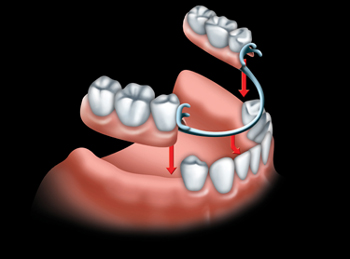
A partial denture
Complete dentures are what we most often refer to as “false teeth.” They are also called “full dentures” and are used when all your natural teeth are missing. Complete dentures are removable as they are held in place by suction. They can cause soreness at first and take some time to get used to. There are 2 types of complete dentures: immediate dentures and conventional dentures.
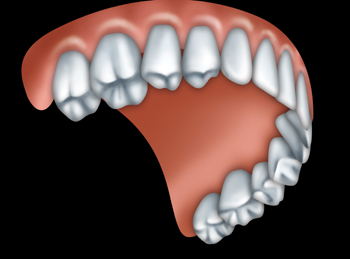
A full upper denture
Immediate dentures are made before your teeth are removed. Your dentist takes measurements and makes models of your jaws during your first visit. Once your teeth are extracted, your dentist inserts the immediate dentures. The benefit of immediate dentures is that you are not without teeth during the healing period, which can take up to 6 months. During the healing period, your bones and gums can shrink and your immediate dentures may need to be relined by your dentist for a proper fit.
Conventional dentures are made and inserted into your mouth after your teeth have been extracted and the gums and jaw tissues have healed.
Overdentures
If you are having trouble with your complete dentures, your dentist may suggest overdentures. An overdenture is a removable denture that fits over the natural teeth left in your mouth or over dental implants. If you have some natural teeth left, they are reshaped to fit in the denture. If there are no natural teeth left, small implants are placed into the jawbone. The overdenture attaches to the implants or rests on the natural teeth.
Caring for your Dentures
Complete and partial dentures need to be cleaned every day just like natural teeth. Otherwise, plaque and tartar can build up on your dentures and cause stains, bad breath and gum problems. Plaque from your dentures can also spread to your natural teeth and gums, causing gum disease and cavities.
To clean your dentures, remove them from your mouth and run them under water to rinse off any loose food particles. Then wet a denture brush or a regular soft-bristle toothbrush and apply denture cleaner or a mild soap. Household cleaners and regular toothpaste are too abrasive and should not be used for cleaning dentures. Gently brush all surfaces of the dentures including under the clasps where bacteria collect. Be careful not to damage the plastic or bend the attachments. Rinse your dentures well in clean water before placing them back in your mouth.
While your dentures are removed, be sure to clean and massage your gums. If your toothbrush hurts your gums, run it under warm water to make it softer or try using a finger wrapped in a clean, damp cloth. If you have partial dentures, brush your natural teeth with a soft-bristled toothbrush and floss.
Always remove your dentures overnight to give your mouth a chance to rest. Soak them in warm water with or without denture cleanser. If your dentures have metal clasps, only use warm water for soaking, as other soaking solutions can tarnish the metal. When you’re not wearing your dentures, keep them in water to stop them from drying out or warping. Never use hot water for soaking.
Dentures can break if dropped or squeezed too tightly. When you are handling your dentures, stand over a folded towel or a sink of water just in case you accidentally drop them.
Look for cracks in your dentures. If you find any, take them to your dentist for repair. See your dentist regularly and at least once a year. Your mouth is always changing, so your dentures will need adjusting or relining from time to time to make sure they fit well. Poorly fitted dentures may cause denture sores that make oral cancer more difficult to spot. At your dental exam, your dentist will also examine your gums for any signs of disease or oral cancer and any natural teeth you may have for signs of decay or infection.
 Copyright © Canadian Dental Association, Inc.
Copyright © Canadian Dental Association, Inc.
Content reproduced with permission.
Crowns - Restoring Damaged Teeth
If your tooth is damaged but not lost, a crown can be used to restore its shape, appearance and function. You may need a crown if you have a root canal, a large filling in a tooth or a broken tooth.
A crown, also called a cap, is a hollow, artificial tooth used to cover a damaged or decayed tooth. The crown restores the tooth and protects it from further damage. Crowns can also be used to cover a discoloured or misshapen tooth. A tooth that has been fixed with a crown looks and works very much like a natural tooth.
How a crown is done
- Your dentist gives you a local anesthetic.
- To make room for the crown, your dentist files down the tooth that needs to be restored.
- An impression of the filed-down tooth and nearby teeth is taken. This impression is used to custom make your final crown. The crown is built using restorative material (material used for fillings) based on the impression. The final crown will be the right shape for your mouth.
- Until your final crown is ready, your dentist places a temporary crown over the tooth that needs to be restored. The temporary crown is made from an impression of your tooth before it was filed down. It protects your tooth until the final crown is ready. A temporary crown may not have the same shape and colour as a final crown.
- On your next visit, your dentist takes off the temporary crown and puts on the final one. Your dentist checks to make sure the crown is the right fit, shape, colour and bite. If it is, your dentist cements the crown into place.
These are the steps dentists most often follow in making a crown, but your tooth may need special care. You may need orthodontic treatment, gum treatment or root canal treatment. It may take more than 2 visits to your dentist, or your visits may last longer.

Different types of crowns
Crowns are made from various types of materials. Depending on which tooth needs a crown, your dentist will suggest a material, or combination of materials, that is right for you.
Metal crowns are made of gold. They generally last a long time and won’t chip or break. They tend not to wear down your opposing natural teeth. However, the gold colour does not look natural, particularly on front teeth.
Composite crowns look natural. They won’t chip as easily as porcelain crowns, but they tend to wear more quickly from chewing. Tooth brushing tends to remove the highly polished surface of composite crowns and this causes them to stain more easily.
Porcelain crowns look the most natural. They are more brittle than metal or composite and may chip more easily. Because of this, they are not usually placed on back teeth.
Porcelain-fused-to-metal crowns look natural and are stronger than porcelain or composite crowns. They won’t chip as easily as porcelain or ceramic crowns. However, depending on their design, the metal may show if your gums are thin or shrink.
What else should I know?
Crowns are strong and generally last for about 10 years or longer if you take good care of them. Brush and floss your crown, just like you clean your natural teeth. Crowns may not be as strong as your natural teeth. So like your natural teeth, remember not to bite down on hard objects or use your teeth to open or cut things.
 Copyright © Canadian Dental Association, Inc.
Copyright © Canadian Dental Association, Inc.
Content reproduced with permission.
Fillings
When you go for a dental exam, your dentist checks your fillings and may suggest that you replace any loose or broken ones. Your dentist also looks for signs of decay, such as brown or black spots and may want to use X-rays to take a closer look at problem spots.
If you have a cavity, your dentist may keep an eye on it (if it's small) or fill it right away. If a large cavity is not filled, it can get bigger and cause pain. The tooth may even have to be removed and replaced with a false (or artificial) tooth.
Overview - If you have a cavity and it needs a filling, there are different kinds of fillings to do the job.
Metal Fillings - Dental amalgam is the most common type of filling used in Canada today but other metal fillings may be appropriate depending on your oral health needs.
Tooth-coloured Fillings - Composite fillings and fillings made out of glass ionomer materials are the same colour as your natural teeth.
Overview
If you have a cavity and it needs a filling, there are different kinds of fillings to do the job.
Your dentist cares about you and your oral health. If you have any questions or concerns about fillings, talk to your dentist. He or she will advise you on the type of filling that works best in your particular case, and inform you about the aesthetic and cost implications for each type.
There are several different types of fillings that can be used to fill a cavity, but the final decision on which type of filling is placed in your mouth is yours alone.
How Fillings Are Done
To fill a cavity, your dentist may first give you "freezing" (or local anesthetic), so you do not feel any pain. Your dentist then takes out all traces of decay, shapes the hole and fills it.
Most fillings are done in two ways:
- Direct Filling - These fillings go right into the cavity, after your dentist has cleaned out the decay. Amalgam (or silver) fillings and plastic (or white) fillings are examples of direct fillings. They harden quickly. Most of the time, you will be able to have a direct filling put in place in one appointment.
- Indirect Filling - Examples of this type of filling are crowns (or caps) and inlays. They are custom made in a lab to fit your tooth. Your dentist cements the filling in place. Most indirect fillings take two or more appointments to complete.
Dental amalgam is the best-known direct material. Cast gold alloy is the most durable indirect material. However, ceramics are gaining in popularity because of their longevity relative to other tooth-coloured materials.
Remember, your dentist is interested in you and your oral health. If you are concerned about having any particular dental restorative materials placed in your teeth, talk to your dentist and be a partner in decisions about your oral health care.
Health Canada's Role
One of Health Canada's jobs is to make sure that dental fillings and dental tools are safe. CDA supports Health Canada's role in making sure that Canadians receive the best possible care when they visit their dentist.
Visit Health Canada's Web site.
Metal
1. Dental Amalgam Fillings
Dental amalgam fillings are sometimes called "silver" fillings. They are the most common type of filling used in Canada today. Because these fillings are silver in colour, they are used to fill back teeth. They are a mix of metals such as mercury, silver, copper and tin.
- Advantages
- These fillings are the least expensive type of filling.
- They last a long time.
- They are easy to put in place; because they are a direct filling, one visit to your dentist will do the job, in most cases.
- Disadvantages
- The silver colour may not appeal to people who want a "natural" look.
- Tiny amounts of mercury are released from the filling when you chew. For most people, this bit of mercury is nothing to worry about. Studies have shown that amalgam fillings do not cause illness. They have been used on people for more than 150 years.
- Health Canada advises pregnant women in need of a filling to wait until the baby is born before they go ahead with the procedure. Your dentist can suggest other kinds of fillings, if the work is urgent.
2. Cast Gold Fillings
Cast gold fillings are based on a model (or cast) of your tooth. Cast gold fillings are a mixture of gold with other metals such as silver and copper. These other metals make gold fillings more durable.
A cast gold filling is made in a dental lab and sent back to your dentist, who cements it in place in your mouth. You will need at least two visits to the dentist to get the job done. During the first visit, your dentist cleans out all the decay and makes a mold of your tooth. The hole is filled with a temporary filling.
Meanwhile, in a dental lab, the mold of your tooth is used to make a model. A filling that is the same size and shape as your tooth is built, based on the model. When you go back to the dentist a couple of weeks later, the gold filling is cemented in place.
- Advantages
- Gold is stronger than amalgam.
- Gold fillings last a long time.
- Disadvantages
- Gold costs more than other kinds of fillings.
- Gold fillings and crowns are indirect fillings, so they require at least two appointments.
- The gold colour may not appeal to people who want a "natural" look.
Tooth-coloured
1. Composite Fillings
Composite fillings are also called plastic or white fillings. Getting this kind of filling depends on where the tooth is in your mouth. We bite down hard on our back teeth (molars), so a plastic filling may not be a good choice. Talk to your dentist about other options.
To place this filling, your dentist cleans all decay from the tooth and puts a glue (or bonding material) on the inside of the hole. Composite resin is put into the hole in thin layers. Each layer gets hard with the help of a special light that your dentist holds over the tooth. When the last layer of the filling is hard, your dentist shapes the filling so it looks and feels natural.
- Advantages
- These fillings will be the same colour as your natural teeth.
- They cost less than gold fillings.
- They are direct fillings, so they can be done in one appointment, in most cases.
- Disadvantages
- This kind of filling can break more easily than amalgam or gold fillings, and may not last as long.
- Composite fillings cost more than amalgam fillings.
- Recurrent decay is more of a problem than with amalgam or gold fillings.
2. Glass Ionomer Materials
Glass ionomer materials are only used in teeth where you do not bite down hard. There have not been many studies about how long this kind of filling lasts. Newer forms of the filling may be stronger and last longer. Research is underway to evaluate the effectiveness of these materials.
- Advantages
- These fillings are the same colour as your natural teeth.
- They contain fluoride, which helps stop recurrent decay in the tooth.
- They do not have to be put in layer by layer; thus, they are simpler to put in than composite resins.
- They are direct fillings and can be done in one appointment, in most cases.
- They cost less than gold fillings.
- Disadvantages
- They are not as strong and will not last as long as other fillings.
- They cost more than amalgam fillings.
3. Porcelain Materials
Porcelain materials are the most common type of dental ceramic used by dentists. They are hard and brittle. Porcelain and metal can be combined to make a strong, tooth-coloured crown.
Dental porcelain is made in a dental lab. Unless you have a bad tooth-grinding habit or some other problem, a combination of porcelain and metal can be used anywhere in the mouth.
- Advantages
- Dental porcelain is the same colour as natural teeth.
- These fillings last a long time.
- Disadvantages
- For teeth that bite down hard - like molars - ceramics are not a good choice. Fillings can break.
- They are indirect fillings, so at least two appointments will be needed.
- They cost more than most other types of fillings.
 Copyright © Canadian Dental Association, Inc.
Copyright © Canadian Dental Association, Inc.
Content reproduced with permission.
Root Canal Treatment
When the nerve of your tooth becomes infected, a successful root canal treatment lets you keep the tooth rather than having to pull it out. Keeping your tooth helps to prevent your other teeth from drifting out of line and causing jaw problems. Saving a natural tooth avoids having to replace it with an artificial tooth.
What is root canal treatment?
Root canal treatment, also known as endodontic treatment, is the process of removing infected, injured or dead pulp from your tooth. The space inside the hard layers of each tooth is called the root canal system. This system is filled with soft dental pulp made up of nerves and blood vessels that help your tooth grow and develop.
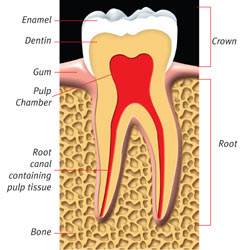
A healthy tooth.
When bacteria (germs) enter your tooth through deep cavities, cracks or flawed fillings, your tooth can become abscessed. An abscessed tooth is a tooth with an infection in the pulp. If pulp becomes infected, it needs to be removed. An abscessed tooth may cause pain and/or swelling. Your dentist may notice the infection from a dental x-ray or from other changes with the tooth. If left untreated, an abscessed tooth can cause serious oral health problems.
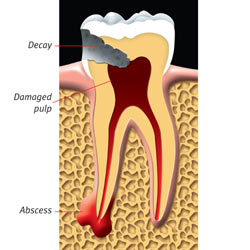
An abscessed tooth.
If your child's primary (baby) tooth is damaged, your dentist may refer you to a pediatric dentist for this procedure. A pediatric dentist has at least 2 years of extra university training in treating children.
How is a root canal treatment done?
- The dentist gives you a local anesthetic (freezing).
- To protect your tooth from bacteria in your saliva during the treatment, the dentist places a rubber dam around the tooth being treated.
- The dentist makes an opening in the tooth to reach the root canal system and the damaged pulp.
- Using very fine dental instruments, the dentist removes the pulp by cleaning and enlarging the root canal system.
- After the canal has been cleaned, the dentist fills and seals the canal.
- The opening of the tooth is then sealed with either a temporary or permanent filling.
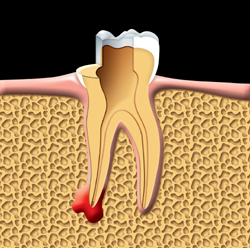
The damaged pulp is removed.
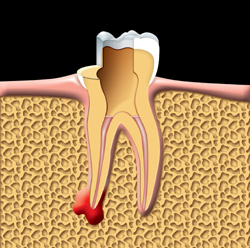
The root canals are filled and sealed.
Tooth restoration after root canal treatment
After a root canal treatment, your tooth has to be restored (fixed) to look, feel and work as much like a natural tooth as possible. If an endodontist performed your root canal treatment, he or she will fill the opening of the tooth with a temporary filling and send you back to your dentist for tooth restoration.
Your dentist may use a permanent filling or a crown to restore your tooth. The choice of restoration will depend on the strength of the part of the tooth that's left. A back tooth will likely need a crown because chewing puts a great deal of force on back teeth. If there is not enough of the tooth left, posts may be used to help support the crown.
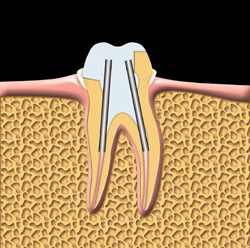
The tooth is prepared for a crown.
Posts are used to help support the crown.

The crown is cemented into place.
What else should I know?
Root canal treatment may be done in 1 or 2 appointments. After root canal treatment, your tooth may be tender for the first week or two. Bad pain or swelling are NOT common. If this happens, call your dentist or endodontist.
You can still get a cavity or gum disease after a root canal treatment. Root canal treatment does not protect your tooth from other types of damage. With proper care and regular dental visits, the tooth could last as long as your other teeth. Most of the time, a tooth that has had a root canal treatment can be saved. However, there are cases where everything possible has been done to save a tooth and still the tooth must be extracted (pulled).
Root canal retreatment
Most root canal treatments are successful. But in some rare cases, a second root canal treatment is needed. This is called retreatment. When retreating a tooth, the root canal filling material is taken out, and the canal is recleaned, reshaped and refilled.
Root canal surgery
Sometimes root canal surgery is needed when a regular root canal treatment cannot be done or when it has not worked. Surgery is done to:
- Check the end of the root for fractures (cracks).
- Remove parts of the root that could not be cleaned during regular root canal treatment.
- Clear up an infection that did not heal after regular treatment.
 Copyright © Canadian Dental Association, Inc.
Copyright © Canadian Dental Association, Inc.
Content reproduced with permission.
Teeth Whitening
In most cases, the natural colour of teeth is within a range of light greyish-yellow shades. Teeth naturally darken with age and their appearance can be affected by the accumulation of surface stains acquired from the use of tobacco products and the consumption of certain foods or drinks.
In addition, the perception of the colour of teeth is severely affected by skin tone and make-up. Independent of the real colour of their teeth, people with darker skin or who use dark makeup will look like they have brighter teeth.
Although teeth are not naturally meant to be completely white, many Canadians want a brighter smile. Responding to this desire, a wide range of "whitening" options has become available to consumers. These products fall into two main categories: surface whiteners and bleaches.
It should be noted that claims related to tooth whitening are seen as cosmetic in nature by Health Canada. These claims must be accurate, so as not to mislead the public. However, the regulator tolerates some puffery or exaggeration. As a consequence, the results of whitening treatment may not be as convincing as consumers originally expected.
Surface Whiteners
These products use special abrasives to improve the product's ability to remove surface stains. Most products in this category are either toothpastes or chewing gums. Because the special abrasives in these whitening products are often only finer versions of what is used in regular toothpastes, they are unlikely to cause excessive tooth wear. However, the effectiveness of these products is limited to surface stains and should not be used as a substitute for professional cleaning.
Bleaches
Most bleaching products are peroxide-based and are actually capable of altering the colours of the tooth itself. However, not all tooth discolourations respond to tooth-bleaching treatments. Individuals contemplating tooth-bleaching should consult with a dentist to determine the cause of the tooth discolouration and to determine whether a bleaching treatment will have the desired result. This step is especially important for patients with fillings, root canal treatments, crowns and/or with extremely dark stains on the anterior teeth.
A number of different bleaching techniques and products are available to patients. Your dentist will use one of these two methods to whiten your teeth:
- Vital bleaching is done on "living" teeth and can be used to whiten your teeth if they have become stained by food or tobacco, or if they have become dark with age.
- Non-vital bleaching is bleaching done on teeth that are no longer "alive." If your tooth has changed colour because of a root canal, non-vital bleaching can lighten your tooth from the inside out.
There are three methods for bleaching teeth. The method that will work best for you depends on the number of teeth that need to be bleached, and on how badly they are stained (or discoloured).
Your dentist may suggest:
- Putting a special bleach on your stained teeth and using heat (or heat and light) to start the bleaching action; or
- Wearing a custom-made mouthguard filled with a special bleach for part of each day; or
- Brushing with a special bleach mixed in toothpaste.
Bleaching should be done only under a dentist's care. Tooth-bleaching under controlled dental office conditions may be safe and effective, but the new in-office vital tooth-bleaching techniques, particularly those using laser and lights, have undergone little scientific assessment.
Home-use tooth-bleaching systems are available to the general public, either from a dentist or from various retail outlets. Clinical studies support the safety and effectiveness of home-use bleaching gels when used appropriately. Tooth sensitivity and irritation to soft tissues can occur during bleaching treatment, but these effects are transient. Yet the effects of long-term tooth-bleaching are unknown and need to be researched, especially since the effect is not permanent and many individuals end up undergoing periodic bleaching treatments.
 Copyright © Canadian Dental Association, Inc.
Copyright © Canadian Dental Association, Inc.
Content reproduced with permission.
Bonding & Veneers
Dental treatments like dental bonding and veneers are not only used to fix cavities or broken teeth but can also be used to improve the look of healthy teeth. Veneers are applied to the entire front surface of the tooth, whereas bonding is applied to a smaller portion of the tooth. Bonding and veneers make your teeth look better by changing their colour, shape, angle or spacing. Your dentist can fix teeth that are broken, chipped or cracked, that have spaces between them or that are discoloured. Cosmetic dental treatment can improve your smile and give you more confidence.
Bonding - What is bonding and how is it done?
Veneers - What are veneers and how are they done?
Bonding
Who does this procedure?
What is bonding?
Bonding, also known as bonded restoration, is a painless way to make minor repairs to teeth. In most cases, several teeth can be bonded in one dental visit. Bonding uses tooth-coloured material, called composite resin. Composite resin is put on the tooth, then shaped and hardened with light. The composite resin can be:
- Matched to your teeth.
- Shaped to look like the missing part of a chipped tooth.
- Used to build up teeth and fill between them.
- Used on a broken tooth to restore it to size.
- Painted over a stained tooth to make it match the colour of your other teeth.
How bonding is done
Your dentist places a matrix between the tooth being treated and its neighbouring tooth. A matrix is a thin, clear plastic film that protects other teeth from stray composite resin.
Your dentist then puts a mild chemical on the tooth to make it a little rough. This helps the composite resin to bond or stick to the enamel of your tooth. The composite resin that matches the colour of your natural teeth is chosen so that the bonding blends in with your teeth. Your dentist puts the composite resin on your tooth in layers. A light is used to harden each layer of the composite resin. After the last layer of composite resin is hardened, your dentist shapes and polishes it to form your tooth. The finished tooth looks natural and smooth. At your next dental visit, your dentist will examine the bonding and polish it if needed. Over time, the bonding may wear down and your dentist may touch up the bonding with more composite resin.
Dental bonding can be used to fix teeth that are chipped.

A clear plastic is placed between the tooth being treated and its neighbouring tooth. Composite resin is put on the tooth in layers.
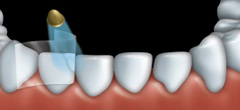
Each layer of the composite resin is shaped and then hardened with a light.
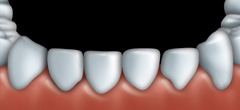
The finished tooth looks natural and smooth.
Veneers
What are veneers?
Veneers are very thin shells that are attached to the front part of teeth. They are often made of porcelain or composite resin. Porcelain veneers are stronger than composite resin veneers and do not change colour or stain. Generally, porcelain veneers take at least 2 dental visits to apply and composite resin veneers can be done in 1 visit. Porcelain veneers generally last longer than composite resin veneers.
How composite resin veneers are done
Much like bonding, your dentist puts a mild chemical on the front surface of the tooth to be veneered to make it a little rough. This helps the composite resin to stick to the enamel of the tooth. The composite resin that matches the colour of your natural teeth is chosen so that the veneer blends in with your teeth. Your dentist then puts the composite resin on your tooth in layers. A bright light is used to harden each layer of the composite resin. After the last layer of composite resin is hardened, your dentist shapes and polishes it to form your tooth. The finished tooth looks natural and smooth.
How porcelain veneers are done
With porcelain veneers, your dentist may give you a local anesthetic (freezing). Your dentist then removes a thin layer of the enamel from your teeth to make room for the veneers. Then your dentist makes a mold of your teeth. This mold is used to custom-make your porcelain veneers. In the meantime, your dentist may place temporary veneers to replace the portion of the tooth that was removed. These are worn until your porcelain veneers are ready. The temporary veneers are very fragile and need to be treated gently during eating and cleaning as they come loose very easily
On your next visit, your dentist removes the temporary veneers and puts a mild chemical on your teeth to make them a little rough. This helps the porcelain veneers stick to your teeth better. The porcelain veneers are then glued to your teeth one by one, using composite resin cement.
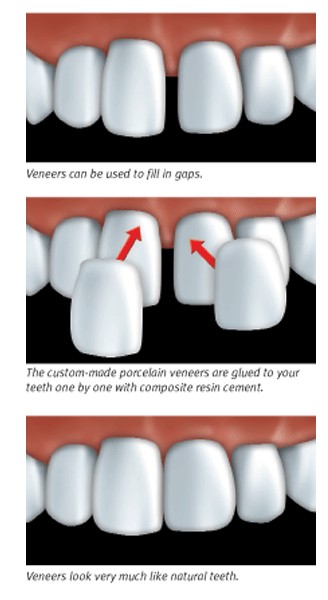
Who can get veneers?
Not everyone is a good candidate for veneers. Here are some reasons why your dentist may suggest treatments other than veneers:
- If a tooth has decay or is in an area that has periodontal disease (gum disease). These problems must be treated first.
- If a tooth has little enamel left, a veneer will not stick to it properly.
- If too much of the tooth is missing, a crown may be another option.
- If a person grinds or clenches his or her teeth. This habit is called bruxism and can chip or break porcelain veneers.
What Else Should I Know?
- Just like your natural teeth, your veneered tooth needs to be brushed and flossed daily.
- If the veneers are not fully placed or sealed onto your tooth, stains or cavities can form under the veneer.
- Once you have veneers, you cannot reverse the treatment because part of your enamel has been removed.
- If a veneer chips or peels off, or if a cavity forms under a veneer, the veneer must be redone. The other option is to put a crown on the tooth.
- Constantly grinding or clenching your teeth may cause your bonding or veneers to chip or break.
- Porcelain veneers and bonded teeth can be chipped if you are not careful when biting or tearing into hard or chewy foods. Do not bite hard objects like ice cubes or fingernails.
- Cosmetic dental treatments like bonding or veneers might not be covered by your dental plan. You may be responsible for those costs yourself.
 Copyright © Canadian Dental Association, Inc.
Copyright © Canadian Dental Association, Inc.
Content reproduced with permission.
Orthodontics at Any Age
People of any age can benefit from orthodontic treatment. Teeth that are crooked, crowded, or that stick out affect the way your teeth look and work. Orthodontic treatment not only improves the look of your smile but your health as well. Straight teeth are easier to clean and less likely to get tooth decay or injured. If you are not happy with the way your teeth look or work, orthodontic treatment may help.
What is orthodontic treatment?
Orthodontic treatment straightens your teeth so they look and work better. Braces or other appliances are used to put gentle pressure on your teeth. Over a number of months or years this pressure can move your teeth into the right position.
Why you may need orthodontics
The position of your teeth and jaws has an effect on your bite. Your bite is how your top and bottom teeth come together. When your top and bottom teeth do not fit together properly, this is called a malocclusion or a bad bite. Problems like missing, crooked, crowded or protruding teeth can contribute to a bad bite. Thumb or finger sucking may also affect your bite.
A bad bite can make it hard to chew some foods and may cause some teeth to wear down. It can also cause muscle tension and pain. Teeth that stick out are more easily chipped or broken. Crowded and crooked teeth are harder to clean and may be more likely to get cavities and gum disease. Fixing a bad bite improves your smile and your health. Different types of bad bites include an overbite, a crossbite, an overjet and an open bite.
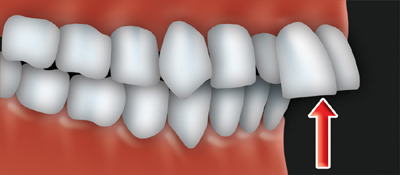
An overjet occurs when the upper front teeth protrude.

A deep bite occurs when the upper front teeth cover the lower front teeth too much.

An underbite occurs when the upper teeth fit inside the arch of the lower teeth.

An open bite occurs when the back teeth are together and there is an opening
between the lower and upper front teeth.
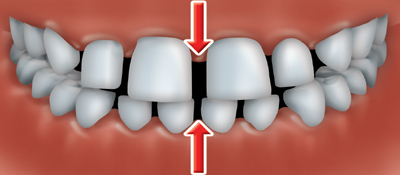
Gaps between teeth
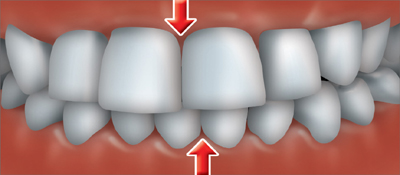
A crossbite occurs when one or more of your upper teeth don’t
line up with the appropriate lower tooth or teeth .
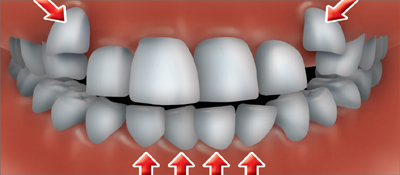
Crowded or overlapped teeth
Who does this procedure?
Your dentist may do basic orthodontic treatment or refer you to an orthodontist. An orthodontist is a dentist who has completed a university post-graduate specialty program in orthodontics. Orthodontics is a specialty of dentistry that deals with preventing and correcting malocclusions.
Who can get orthodontic treatment?
Orthodontic treatment isn’t just for teens, as teeth can be moved at any age. In fact, more and more adults are having orthodontic treatment to improve the look and health of their smile. Your dentist or orthodontist can evaluate if orthodontic treatment is right for you.
In some cases it is helpful to start orthodontic treatment before all the permanent (adult) teeth come in. This is called interceptive orthodontics. Your dentist or orthodontist can do an orthodontic screening to find out if your child will need orthodontic treatment to correct a bad bite. Interceptive orthodontics allows your dentist or orthodontist to treat or stop a problem as it is developing.
How long does treatment take?
Orthodontic treatment takes time. The amount of time depends on your age, the seriousness of your problem and the treatment technique used. Treatment generally involves a visit to your dentist or orthodontist on a regular basis over a period of months to years. In general, it takes longer to treat adults than children or teenagers. Most people wear braces for about 2 years.
Orthodontic treatments
Depending on the extent of your bad bite, your dentist or orthodontist may suggest one or a combination of the following orthodontic treatments to correct your bite:
- Braces.
- Headgear.
- Removable appliances.
- Retainers.
- Oral surgery.
Braces
The most common type of orthodontic treatment used by dentists or orthodontists is braces.
How braces are done
To apply braces, your dentist or orthodontist attaches brackets (or bands) to each tooth with glue. Arch wires are fitted into all the brackets and are usually held in place with rubber or wire ties.

You may feel some discomfort for a while when your braces are first put on and when they are adjusted. It will take a little time to get used to your braces and they can bother your lips and cheeks. If this happens, a relief wax can be applied to your braces. To make eating easier after an adjustment, soft foods are recommended.
Caring for your teeth with braces
Proper brushing and flossing is even more important for people with braces because plaque can easily build up around the edges of your braces. If this plaque is not properly removed, white or brown marks may appear on the enamel surface of your teeth and these marks may be permanent.
Brushing and flossing with braces take longer. It is important to brush your braces as well as the front, back and chewing surfaces of the teeth. Your dentist or orthodontist will give you tips on how to brush and on how to floss using floss threaders. Parents should supervise their children to make sure they do a good job cleaning their teeth and braces and follow the advice of their dentist or orthodontist.
Caring for your braces
If you have braces, do not bite on hard things such as ice cubes and nuts. Do not chew the ends of pens or pencils. Also avoid sticky treats like chewing gum or toffee because they can loosen braces, distort wires and even pull braces off your teeth. If any of these problems happen, you will need to have your braces repaired by your dentist or orthodontist.
If the elastics or ties come off the bracket, you may be able to put them back around the bracket using small tweezers. If a wire is sticking out and bothering your lip or cheek, you may be able to push it back into place with the rubber eraser end of a pencil or it may be carefully cut off with a nail clipper. When a problem happens, always contact your dentist or orthodontist to have your braces checked as soon as possible. Problems that are not fixed can cause the treatment to last longer.
Choices in braces
Today’s braces are smaller and less noticeable. Besides the traditional metal braces, there are tooth-coloured ceramic braces that are less noticeable. Clear aligners are also available for adults. Braces and elastics can also be multicoloured. Speak to your dentist or orthodontist about all your choices.
Headgear
This treatment uses an appliance that fits around the head or neck. It guides the direction of tooth movement and jaw growth in someone who is still growing. There are different types of headgear and they may be worn during any part of the orthodontic treatment. Your orthodontist or dentist will show you how to put on the headgear and tell you how long to wear it each day. In most cases it is worn during the evening and at night.
Removable appliances
Although removable appliances are not as precise as braces, they can move a tooth or a group of teeth. They are fitted by your dentist or orthodontist. Removable appliances can be worn before braces are applied, while braces are worn, or on their own to treat specific problems.
Retainers
Once your braces have been removed, a retainer can be used to keep your teeth in the right place. Retainers are fixed (attached to the teeth) or removable. They may need to be worn all the time or part of the time.
Oral surgery
Tooth removal may be needed if your teeth are crowded or if a tooth is badly out of position. Jaw surgery (or orthognathic surgery) may be needed when there are major differences in the size or position of the upper and lower jaws. If your orthodontist thinks you will need jaw surgery, he or she will refer you to an oral and maxillofacial surgeon.
 Copyright © Canadian Dental Association, Inc.
Copyright © Canadian Dental Association, Inc.
Content reproduced with permission.
Care After Minor Oral Surgery
Oral surgery is any procedure that involves cutting into or removing tissue from your mouth. It includes procedures like removing a tooth, gum surgery, and getting dental implants. Oral surgery also includes getting rid of diseased tissue from the mouth, correcting jaw problems, or repairing a cleft lip or palate.
Who does this procedure?
Your dentist may perform oral surgery or refer you to an oral surgeon, called an oral and maxillofacial surgeon. An oral surgeon is a dentist who has completed a university post-graduate specialty program in oral and maxillofacial surgery.
Oral and maxillofacial surgery is a specialty of dentistry that deals with the surgical treatment of disorders, diseases, injuries and defects of the hard and soft tissues of the oral and maxillofacial regions and related structures.
Sometimes, after minor oral surgery, you may have pain, bleeding and swelling. Proper care after oral surgery will help your mouth heal quickly and cleanly. Here’s what usually happens after oral surgery and how you can deal with it.
You have pain
Once the anesthetic (freezing) wears off, feeling some pain is normal. You might have the most pain in the first 24 to 48 hours after your surgery. Some soreness or discomfort at the site of the surgery may last for 3 to 5 days. The amount of discomfort is different from one person to another and from one operation to another.
What to do
Your dentist or oral surgeon may prescribe medication. Tell your dentist or oral surgeon about any other prescription medicines or herbal supplements you are taking. Take the medication exactly as your dentist or oral surgeon and pharmacist have instructed.
It is important to rest. If you are up and about, you may feel more discomfort. Call your dentist or oral surgeon if the pain does not get any better within 48 hours or at any time if you think there is a problem.
What NOT to do
- Do not take more medication than advised.
- Do not drink alcohol when taking pain relief medication.
- Do not drive or use machines if you are taking narcotic medication. A narcotic may cause you to feel drowsy. Your dentist, oral surgeon or pharmacist will tell you if your pain relief medication is a narcotic.
You have bleeding
You will probably bleed for the first hour or 2 after surgery. The area may continue to ooze for up to 24 hours. Blood and saliva mix together in your mouth and this can make it look like you are bleeding more than you really are. After 4 hours, if you cannot control the bleeding by pressing firmly on the area with a gauze pad, call your dentist or oral surgeon.
What to do
Your dentist or oral surgeon will use a gauze pad over the wound to cut down on the amount of bleeding while the blood clots. This gauze pad should be left in place for an hour no matter how soggy it becomes. Keep firm and constant pressure on the gauze pad by closing your teeth firmly on the pad. If you are still bleeding after 1 hour, put a new gauze pad on the area and continue to put firm and constant pressure on the pad for another hour.
Rest and keep your head raised. Rest slows down the circulation (flow) of blood. This helps stop the bleeding and helps you to heal faster. Brush and floss your teeth as usual, but stay away from the wound and use only a little bit of water. If you are still bleeding a lot and it has been 4 hours or longer since your surgery, call your dentist or oral surgeon.
A full day after surgery, rinse your mouth gently with warm water. Your dentist or oral surgeon may suggest that you add 1/2 teaspoon of salt to a cup of warm water each time you rinse. Rinse 4 or 5 times a day, for 3 or 4 days.
What NOT to do
- Do not rinse your mouth within the first 24 hours, even if the bleeding and oozing leave a bad taste in your mouth.
- Do not chew on the gauze pad or suck on the wound.
- Do not strain yourself for 2 full days after your surgery.
- Avoid hot liquids like coffee and tea. If you eat soup, let it cool first. Hot liquids increase the flow of blood and your wound can start to bleed again.
- Avoid alcohol and tobacco for the first 2 weeks after surgery. They make it harder for the blood to clot and easier for an infection to start. Alcohol and tobacco will also delay healing.
You have swelling
Your face may swell in the first 24 hours after oral surgery. The swelling may last for 5 to 7 days. Once the swelling starts to go down, your face may bruise. The bruising could last for up to 10 days after your surgery.
What to do
On the FIRST day after surgery, put a cold compress on the swollen area. You can make a cold compress by wrapping ice cubes in a towel or you can use a bag of frozen vegetables. Keep the cold compress there for 10 minutes. Take it off for 10 minutes, then put it back on for another 10 minutes. Do this over and over again for the first 24 hours after surgery, if possible.
On the SECOND day after surgery, put something warm on the swollen area. You can make a warm compress by wrapping a hot water bottle or a heating pad in a towel. The warmth will increase blood flow or circulation and bring down the swelling. Do not use anything hot enough to burn your skin. Call your dentist or oral surgeon if the swelling continues to get worse 48 hours after surgery, or if the swelling does not go down within 7 days after surgery.
What NOT to do
- Do not apply heat to the swollen area in the first 24 hours after surgery. This will only make the swelling worse.
Your jaw is sore
After surgery, your jaw muscles may be sore and it may be hard to open your mouth for up to 7 to 10 days. Your jaw muscles may have become stiff and sore from holding your mouth open during surgery.
What to do
If your jaw muscles are not too sore, massage them gently with a warm, moist face cloth. Eat foods that are easy to chew such as eggs, pasta and bananas. Have drinks like milkshakes, milk and juices. If, after 7 to 10 days, your jaw muscles are still tender or your mouth is still hard to open, call your dentist or oral surgeon.
What NOT to do
- Do not force your mouth open.
- Do not chew gum or eat hard or chewy foods.
Warning signs
If you have any of the following problems after oral surgery, call your dentist or oral surgeon right away:
- You are bleeding a lot and it has been 4 hours, or longer, since your surgery.
- You have the feeling that you are going to throw up.
- You are throwing up.
- You have a fever.
- You have pain that does not get any better, and it has been 1 full day or longer since your surgery.
- Your swelling is still getting worse, and it has been 2 days or longer since your surgery.
 Copyright © Canadian Dental Association, Inc.
Copyright © Canadian Dental Association, Inc.
Content reproduced with permission.
Treatment Concerns
Oral health care is a personalized service that requires a good relationship between you and your dentist. If you have a concern about the dental treatment you receive, your dentist would want to know about it.
Your first step is to talk to your dentist and explain your concerns or fears. Your dentist is trained and licensed to provide you with oral health care in a safe and ethical manner and will address any questions you may have about the treatment plan set out for you.
If you feel you cannot discuss your concerns with your dentist, contact the dental regulatory authority for your province. Each province or territory in Canada has a dental regulatory authority that regulates the practice of dentistry and mediates patient complaints.
British Columbia
Provincial AssociationBritish Columbia Dental Association
400-1765 West 8th Avenue
Vancouver, BC V6J 5C6
Tel: (604) 736-7202
Fax: (604) 736-7588
Eml: post@bcdental.org
Web: www.bcdental.org
Provincial Dental Regulatory Authority
College of Dental Surgeons of British Columbia
Registrar
500-1765 West 8th Avenue
Vancouver, BC V6J 5C6
Tel: (604) 736-3621
Fax: (604) 734-9448
Eml: jmarburg@cdsbc.org
Web: www.cdsbc.org
As self-regulating bodies, these regulatory authorities ensure all dentists adhere to codes of conduct and ethical practices under provincial health legislation.
You and your dentist are partners in your oral health care. To alleviate treatment concerns, talk openly with your dentist about your treatment plan and schedule.
 Copyright © Canadian Dental Association, Inc.
Copyright © Canadian Dental Association, Inc.
Content reproduced with permission.

General Dentistry
Fairfield Dental
The majority of dental treatments are carried out to prevent or treat the two most common oral diseases which are dental caries (tooth decay) and periodontal disease (gum disease or pyorrhea). Common treatments involve the restoration of teeth as a treatment for dental caries (fillings), extraction or surgical removal of teeth which cannot be restored, scaling of teeth to treat periodontal problems and endodontic root canal treatment to treat abscessed teeth.
By nature of their general training they can carry out the majority of dental treatments such as restorative (fillings, crowns, bridges), prosthetic (dentures), endodontic (root canal) therapy, periodontal (gum) therapy, and exodontia (extraction of teeth), as well as performing examinations, radiographs (x-rays) and diagnosis. Dentists can also prescribe medications such as antibiotics, sedatives, and any other drugs used in patient management.
Source: ![]() Wikipedia ®
Wikipedia ®
Text is available under the Creative Commons Attribution-ShareAlike License
The Dental Exam
An Overview
The dental exam is critical to your ongoing oral health—and only your dentist can perform this.
The exam consists, in part, of the dentist looking inside your mouth. In the past, you may not have ever realized an exam was taking place. Perhaps you thought the dentist was checking the work the hygienist had just completed.
Not so. The dentist actually looks in your mouth for things that can affect your oral—and your overall—health. Many of these are things you can't see on your own, but that a dentist is trained to detect. Here is some of what your dentist is looking for during a dental exam:
- damaged, missing or decayed teeth
- early signs of cavities
- condition of your gums, such as periodontal pockets, inflammation or other signs of gum disease (which can lead to tooth and bone loss)
- to see how previous dental work such as root canals, fillings and crowns are holding up
- early signs of mouth or throat cancer, such as white lesions or blocked salivary glands
- other suspicious growths or cysts
- position of your teeth (e.g., spacing, bite)
- signs that you clench or grind your teeth (a treatable problem that can cause headache or sore jaw and can, if serious, lead to hearing loss and tooth loss)
- signs of bleeding or inflammation on your tongue and on the roof or floor of your mouth
- the overall health and function of your temporomandibular joint (which joins the jaw to skull), checking for signs of disorders that can cause pain or tenderness
- the general condition of the bones in your face, jaw and around your mouth
The dental exam can catch problems early—before you see or feel them—when they are much easier and less expensive to treat.
As well as the visual inspection of your mouth, the exam includes:
- a complete medical history so the dentist knows about any health conditions that may affect the success of dental treatments or procedures or that may be associated with oral health problems.
It may also include:
- an examination of your neck area, with the dentist feeling the glands and lymph nodes for possible signs of inflammation that could indicate general health problems; and
- dental x-rays, if necessary. These can show such problems as cavities under existing fillings, fractures, impacted wisdom teeth, decay under your gum line and bone loss caused by gum disease.
Your dentist may explain what's happening during the exam and give you a summary of the findings. If not, be sure to ask. As patient, you are a full partner in your oral health care.
Checklist
Be Sure to Tell Your Dentist
The more your dentist knows about your overall health, the more effective they can be in addressing your oral health care needs. Be sure to mention:
- any new medical conditions you've been diagnosed with since your last visit, such as diabetes or AIDS, even if they don't seem pertinent. Your dentist needs to know to properly manage your treatment and prevention program.
- any new medications you're taking (side effects can often include dry mouth and overgrown gums)
- if you're pregnant
- if you have any allergies
- any changes you've noticed in your teeth, such as changes in colour, looseness or position
- any changes you've noticed in your gums, such as bleeding when you brush or floss, or changes in appearance
- any increased sensitivity to heat, cold or sweets
- whether your floss catches on rough edges, causing it to shred
- any colour changes in the skin on the inside of your mouth
- if you smoke or chew tobacco (which increases the likelihood of oral cancer)
- if your neck or jaw muscles are tight or if you're aware of clenching or grinding your teeth
- if you're nervous about going to the dentist—new ways of doing things have made modern dentistry more comfortable for patients, and talking to your dentist may reassure you and help you feel more relaxed
 Copyright © Canadian Dental Association, Inc.
Copyright © Canadian Dental Association, Inc.
Content reproduced with permission.
Professional Cleanings
Cleanings will be done either with an ultrasonic scaler or hand scaler to remove plaque and tartar. Mechanical polishing is done to remove stains if needed.
The frequency of cleanings is based on individual need, as some people benefit from having cleanings more often.
 Copyright © Canadian Dental Association, Inc.
Copyright © Canadian Dental Association, Inc.
Content reproduced with permission.
Oral Cancer Screening
Through the use of the Velscope™, we offer cutting edge oral cancer screening.
FAQ
What is the VELscope?
The VELscope is the first adjunctive device cleared by the FDA and Health Canada to help clinicians detect cancerous and pre-cancerous lesions and other lesions that might not be apparent to the naked eye. The VELscope is also cleared to help surgeons determine appropriate surgical margins.
What is the VELscope Vx?
The VELscope Vx is LED Dental Inc.'s newest model release of the VELscope system. The VELscope Vx is
- cordless
- portable
- completely safe
- simple to use
- no unpleasant rinses
- no stains
- entire exam in about two minutes.
How does it work?
The VELscope's blue light excites natural "fluorophores" in mucosal tissues. In turn, the fluorophores emit their own light — in shades of green, yellow and red. The VELscope's proprietary filter makes fluorescence visualization possible, by blocking reflected blue light, and by enhancing the contrast between normal and abnormal tissue.
What is tissue fluorescence?
Tissue fluorescence is an optical phenomenon that occurs when light absorbed by human tissue creates a molecular excitation that re-emits light at a different wavelength.
Is the VELscope a diagnostic tool?
Like other visualization technologies, such as panoramic radiography, CT, MRI, PET and ultrasound, the VELscope is NOT a stand-alone diagnostic test. However, used in conjunction with the standard oral soft tissue exam, VELscope provides visual information that cannot be acquired in any other way.
How long does a VELscope exam take to perform?
In less than 3 minutes, with no rinses, dyes or discomfort, a VELscope examination helps healthcare professionals assure their patients that their oral mucosa has been assessed to an advanced level of preventative care.
Is the VELscope safe?
Yes, the VELscope system is completely safe. All that's being shone into the oral cavity is blue light, generated by light emitting diodes.
Does the VELscope generate "false positives" for oral cancer?
False positives occur when a diagnostic test mistakenly signals the presence of disease. The VELscope system is NOT a diagnostic test, and does not, consequently, generate false positives. As an adjunctive visualization tool, the VELscope helps dental professionals discover a wide range of unhealthy tissue in the mouth, including oral pre-cancer and cancer.
Copyright © Velscope™
Fluoride Treatments
Fluoride therapy is the delivery of fluoride to the teeth topically or systemically in order to prevent tooth decay (dental caries) which results in cavities. Most commonly, fluoride is applied topically to the teeth using gels, varnishes, toothpaste/dentifrices or mouth rinse.
Systemic delivery involves fluoride supplementation using water, salt, tablets or drops which are swallowed. Tablets or drops are rarely used where public water supplies are fluoridated.
The need for a fluoride treatment is determined on an individual basis in consideration of the risk of cavities. This can be especially important for children and for older adults with exposed root surfaces.
Source: ![]() Wikipedia ®
Wikipedia ®
Text is available under the Creative Commons Attribution-ShareAlike License
Tooth Desensitization
At-home treatments
At-home treatments include desensitizing toothpastes or dentifrices, potassium salts, mouthwashes and chewing gums.
In-office treatments
In-office treatments might be much more complex and they may include the application of dental sealants, having fillings put over the exposed root that is causing the sensitivity, or a recommendation to wear a specially made night guard or retainer if the problems are a result of teeth grinding.
Other possible treatments include fluorides are also used because they decrease permeability of dentin in vitro. Also, potassium nitrate can be applied topically in an aqueous solution or an adhesive gel. Oxalate products are also used because they reduce dentin permeability and occlude tubules more consistently. However, while some studies have showed that oxalates reduced sensitivity, others reported that their effects did not differ significantly from those of a placebo. Nowadays, dentine hypersensitivity treatments use adhesives, which include varnishes, bonding agents and restorative materials because these materials offer improved desensitization.
Source: ![]() Wikipedia ®
Wikipedia ®
Text is available under the Creative Commons Attribution-ShareAlike License
Sealants
Dental sealants are thin plastic coatings that are applied to the grooves on the chewing surfaces of the back teeth to protect them from tooth decay. Most tooth decay in children and teens occurs on these surfaces. Sealants protect the chewing surfaces from tooth decay by keeping germs and food particles out of these grooves.
Permanent molars are the most likely to benefit from sealants. The first molars usually come into the mouth when a child is about 6 years old. Second molars appear at about age 12. It is best if the sealant is applied soon after the teeth have erupted, before they have a chance to decay.
Applying sealants does not require drilling or removing tooth structure. The process is short and easy. After the tooth is cleaned, a special gel is placed on the chewing surface for a few seconds. The tooth is then washed off and dried. Then, the sealant is painted on the tooth. The dentist or dental hygienist also may shine a light on the tooth to help harden the sealant. It takes about a minute for the sealant to form a protective shield.
Sealants can only be seen up close. Sealants can be clear, white, or slightly tinted, and usually are not seen when a child talks or smiles.
As with anything new that is placed in the mouth, a child may feel the sealant with the tongue. Sealants, however, are very thin and only fill the pits and grooves of molar teeth.
A sealant can last for as long as 5 to 10 years. Sealants should be checked at each regular dental appointment and can be reapplied if they are no longer in place.
Source: ![]() Wikipedia ®
Wikipedia ®
Text is available under the Creative Commons Attribution-ShareAlike License
Custom Sports Mouthguards
There are 3 basic types of mouthguards. Your dentist can explain the difference in cost and comfort, and how well they can protect you or your child.
- Stock mouthguards are inexpensive and come pre-formed, ready to wear. They can be bulky and can make breathing and talking difficult.
- Boil and bite mouthguards are available at many sporting goods stores. They can offer a better fit than stock mouth protectors and are softened in warm or hot water, according to manufacturer’s instructions. By softening the mouthguard, it can more easily take to the shape of your mouth.
- Custom-fitted mouthguards are made especially for you by your dentist. They are more expensive than the other types, but they offer a better fit. Your dentist can make a mouthguard that’s a perfect fit for your mouth.
...but accidents do happen, and knowing what to do can mean the difference between saving and losing a tooth. When you or a member of your family has a serious problem with a tooth, you need help fast.
 Copyright © Canadian Dental Association, Inc.
Copyright © Canadian Dental Association, Inc.
Content reproduced with permission.
Grinding Guards
Your dentist may suggest wearing a night guard, also called an occlusal splint. It is made of clear plastic and fits over the biting surfaces of the teeth of one jaw so that you bite against the splint rather than your teeth. This often helps your jaw joints and muscles to relax.

An occlusal splint is made of plastic and fits
over the biting surfaces of the teeth of one jaw.
 Copyright © Canadian Dental Association, Inc.
Copyright © Canadian Dental Association, Inc.
Content reproduced with permission.
Preventive Care
How Not to See Your Dentist
(more than necessary)
Good preventive oral care at home can save you money—it can also save your teeth, freshen your breath, and improve your oral and overall health.
The Six Steps of Preventive Care
- Brush at least twice a day.
- Floss once a day.
- Limit sugary snacks and drinks (including fruit juices).
- Don't smoke or use any tobacco products.
- Have an examination as often as is recommended by your dentist. The frequency will be based on your individual needs and the risk of oral diseases.
- Have your teeth cleaned and polished as per the schedule recommended by your dentist.
Examinations—Once, Twice or More per Year?
Examinations are an important part of maintaining healthy teeth and gums and the frequency should be determined in consultation with your dentist. Some people need more frequent examinations while others can have a yearly exam.
Back to the Basics—A Refresher on Brushing and Flossing
Brushing and flossing remove the bacteria that promote tooth decay and the plaque that can cause gum disease. A reminder of what works best:
- Ideally, brush after every meal—but at least twice a day including just before bed.
- Use a soft-bristle brush with rounded bristles, small enough to reach your back teeth.
- Use a toothpaste with fluoride—look for the CDA seal.
- Brush for at least two minutes.
- Don't forget to gently brush your tongue.
- Get a new toothbrush if yours looks worn, is more than three months old, or if you've had a cold (bristles can harbour germs that may re-infect you).
- Flossing is a must—otherwise more than a third of your tooth surface is not getting cleaned.
- Consider an interdental cleaner or proximal brush for cleaning between your teeth instead of floss if you have wide spaces between your teeth, wear braces, or have had gum surgery.
- Brushing and flossing aren't complicated, but technique does matter. Ask your dentist or click here for a visual guide.
Watch Your Mouth!
Preventive care also means being alert for signs of tooth decay, gum disease, and oral cancer. If you see any of the warning signs listed below, contact your dentist right away.
Tooth decay
- sensitivity to heat, cold, sweetness, or pressure
Periodontal disease (gum disease)
- red, shiny, puffy, sore, or sensitive gums
- bleeding when you brush or floss
- persistent bad breath
Oral cancer
- bleeding that you can't explain
- open sores that don't heal within 7 to 10 days
- white or red patches
- numbness or tingling
- small lumps or thickening on your gums, the sides or bottom of your tongue, the floor or roof of your mouth, or the inside of your cheeks
You and Your Dental Team — Working Together
By practising good preventive care at home, you are working together with your dentist to safeguard and improve your oral health. Click here to meet the rest of your oral health team members.
 Copyright © Canadian Dental Association, Inc.
Copyright © Canadian Dental Association, Inc.
Content reproduced with permission.
